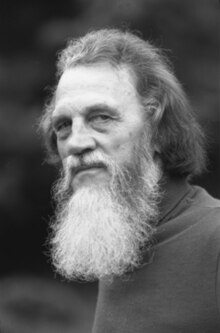Eggert Gustavs
Eggert Gustavs (born October 6, 1909 in Kloster, Hiddensee ; † January 13, 1996 in Neuruppin ) was a German painter and graphic artist . He is one of the most important Hiddensee artists. His grave is in the cemetery of the Inselkirche in Kloster auf Hiddensee under a boulder with a hand-carved sign.
Life
Eggert Gustavs was born on October 6, 1909 in the parsonage of Kloster on the island of Hiddensee. He was the youngest son of the island pastor and ancient orientalist Lic. Arnold Gustavs and his wife Helene Gustavs, b. Lützow. In the first years of school he was tutored with his siblings at home by private teachers, at the age of nine he went to school in Stralsund to a boarding school . Eggert Gustavs' school days, as well as all of his subsequent life, were overshadowed and shaped by a variety of illnesses that often made it impossible for him to attend school for months - at the age of 17 almost a year - and consequently prevented a regular school leaving certificate.
After an apprenticeship as a carpenter in Hamburg from 1928 to 1930, which was a prerequisite for studying architecture, he attended the State Art School in Hamburg until 1932. The painter and graphic artist Wassily Kandinsky exerted a formative influence on him at the Bauhaus in Berlin in 1933. After the Bauhaus closed in the same year, he trained himself to become a painter and graphic artist. From 1934 he lived as a freelance artist in Neuruppin. From 1939 he worked as a technical draftsman. In 1942 he was drafted into the flak and in 1944 deployed as a "Vorobener Beobachter" on the Oder. He was wounded and taken to Siberia as a prisoner of war.
After returning home in 1947 and resuming work as a freelance artist in 1948, he lived and worked in Neuruppin in the winter and in Hiddensee in the summer. Eggert Gustavs died on January 13, 1996 in Neuruppin.
plant
Watercolors and woodcuts were Gustavs' most important means of expression, but he also created unmistakably independent works with brush or reed pen drawings, oil , pastel , pencil , glass printing or figural wood carvings . A special skill emerged in the portraits and in the caricatures : he had a great talent for capturing typical things with limited artistic means. As he put it, he was fascinated by the “face of the landscape” and the “landscape of the face”.
The artist's work was primarily shaped by his home island of Hiddensee. But he also captured the tranquility and tranquility of the Brandenburg landscape, the lakes and forests of Ruppin Switzerland, which Theodor Fontane described in his " Walks through the Mark Brandenburg ".
With a few exceptions, Gustavs limited himself to medium and small formats for his pictures. Eggert Gustavs often emphasized that he had and needed no role models, no teachers, that he was not attached to any “school” and that he trained himself as an autodidact. He once wrote: “I am pleased that I have not studied my profession. So I have no need to get rid of anything that may have been imprisoned in order to be clearly myself. "
His pictures were shown at exhibitions in Potsdam, Rheinsberg, Schwerin, Remscheid, Neuruppin and Barcelona, but above all at Hiddensee. Thousands of visitors have visited the permanent exhibition in its artist's cave in the "Gustavs House" in Kloster over the decades.
Gustavs has given a significant part of his work to the local museum of the island of Hiddensee in Kloster. Another collection is still owned by the family, while a large part of his works is widely distributed in private hands.
Web links
- Literature about Eggert Gustavs in the state bibliography MV
- Website about Eggert Gustavs with detailed information and work examples
| personal data | |
|---|---|
| SURNAME | Gustavs, Eggert |
| BRIEF DESCRIPTION | German painter and graphic artist |
| DATE OF BIRTH | October 6, 1909 |
| PLACE OF BIRTH | Monastery , Hiddensee |
| DATE OF DEATH | January 13, 1996 |
| Place of death | Neuruppin |




